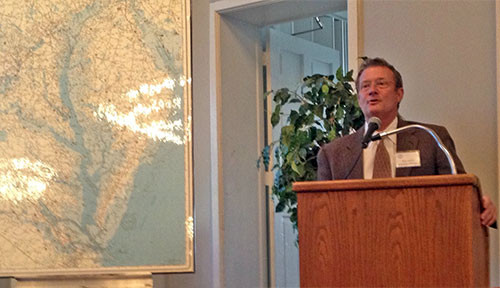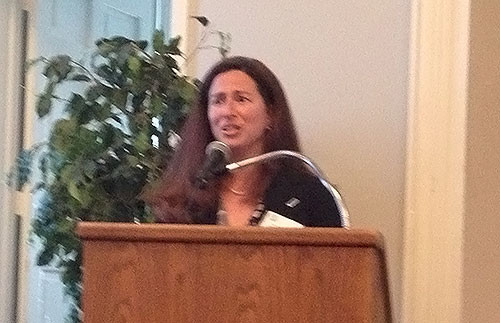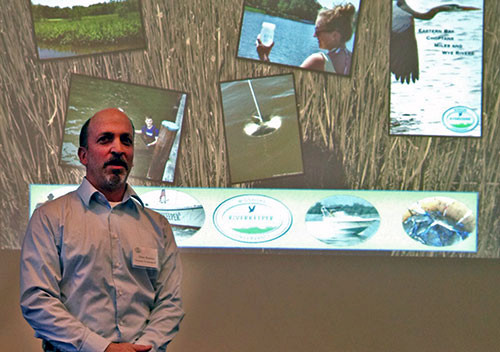Midshore Riverkeeper Conservancy report card launch
Bill Dennison ·On April 13, I was a speaker at the report card launch of the Choptank and Miles-Wye Rivers, sponsored by the Midshore Riverkeeper Conservancy in Easton, Maryland. The launch was held in the beautiful Talbot County Historical Society auditorium. Tim Junkin, the Executive Director of Midshore Riverkeeper Conservancy, was the Master of Ceremonies. The event was very well attended, with well over a hundred people in attendance, far exceeding expectations. In addition to the speakers, the event included constructing a montage of the Bay, with birds, crabs and fish that individuals could each contribute an organism. My contribution was a cow-nosed ray.


The first speaker was Dr. Jana Davis, Executive Director of the Chesapeake Bay Trust. We have been working with the Trust for several years in developing the Mid Atlantic Tributary Assessment Coalition, and Jana has been a real visionary leader.

My remarks were centered around the impact of large storms on Chesapeake Bay, the Conowingo Dam controversy and Chesapeake Bay report card. In addressing the issue of storm impact on Chesapeake Bay, I drew from the 20 pp. booklet that IAN generated 'Responding to major storm impacts: Ecological impacts of Hurricane Sandy on Chesapeake and Delmarva Coastal Bays'. The issue of Conowingo Dam has been controversial in the region due to a perception that scouring from behind the dam is degrading Chesapeake Bay tributaries. The most compelling refutation of this argument is a satellite photograph of Chesapeake Bay after Tropical Storm Lee. Intense rainfall in the Susquehanna River basin associated with this 2011 storm resulted in the third highest flows recorded for the Susquehanna River. Sediments from behind the dam were scoured and a plume of muddy water was clearly visible from space. This plume extended down to the mouth of the Potomac River, yet the tributaries of the Delmarva peninsula, including the Choptank and Miles-Wye Rivers were not turbid. This sediment 'tracer' for Susquehanna River water served to demonstrate that the major sources of pollution for these Chesapeake tributaries are the watersheds of the tributaries, NOT the Susquehanna River.
The Choptank River scores within the overall Chesapeake report card are highly variable from year to year, compared to other regions that are either consistently good (e.g., Lower Bay) or consistently poor (e.g., Patabsco/Back Rivers). In addition, the Choptank report card scores are not on upward trajectories (e.g., Upper Western Shore) or downward trajectories (e.g., Upper Eastern Shore), and the importance goal for the Choptank and Miles-Wye Rivers is to get in an upward trajectory. The way to track this progress is through the annual report cards.
The University of Maryland Center for Environmental Science has a unit called the Integration and Application Network (IAN). The IAN group has partnered with the Chesapeake Bay Trust for the past several years to develop tools to aid the riverkeepers. We have produced standardized, rigorous protocols for sampling, analysis and reporting that the riverkeepers can use to assess their water bodies and produce their report cards. The Midshore Riverkeeper Conservancy has adopted these protocols.
The Chesapeake Bay Program is celebrating their thirtieth anniversary this year, and yet the Bay remains in peril. I believe that the 'game-changer' that has emerged recently is the active local engagement of riverkeepers and waterkeepers with groups of citizen scientists. This small army of citizen scientists can monitor, assess and evaluate the status of their waterways and work with their neighbors in the community to implement practices that can create the upward trajectory of improving stream, river and ultimately Bay health. The heroes in this room are the riverkeepers, Drew Koslow, Tom Leigh and their team of citizen scientists. I applaud you.


My remarks were followed by the presentation of the Choptank River report card by Drew Koslow and the Miles-Wye River report card by Tom Leigh. The enthusiasm of the riverkeepers, combined with the responsive audience provided a sense of commitment, focus and engagement that far exceeds anything that I have observed in Annapolis. While the various government initiatives are key to providing adequate resources and the needed regulations, it is these groups of engaged citizens that will change the trajectory of Chesapeake Bay restoration.
About the author
Bill Dennison

Dr. Bill Dennison is a Professor of Marine Science and Vice President for Science Application at the University of Maryland Center for Environmental Science.
Next Post > Everything Down the Drain - Why?
Comments
-
Nancy Eash 13 years ago
Keep up the good work.
In conjunction with all this work I hope that everyone will also stress an anti littering program.

